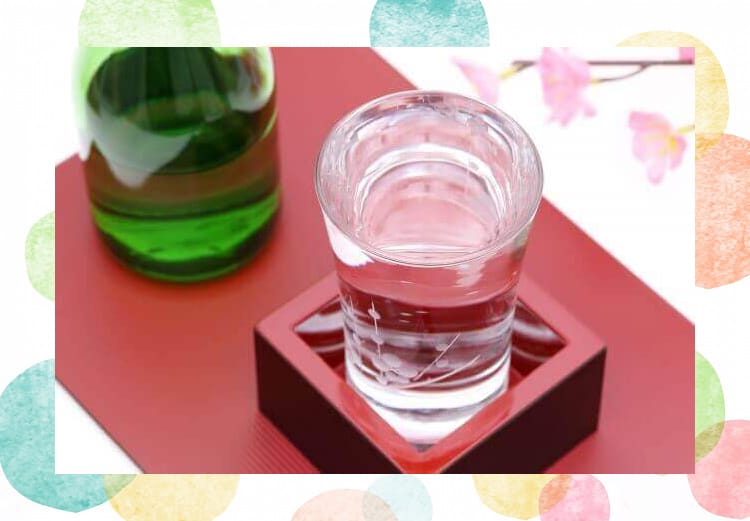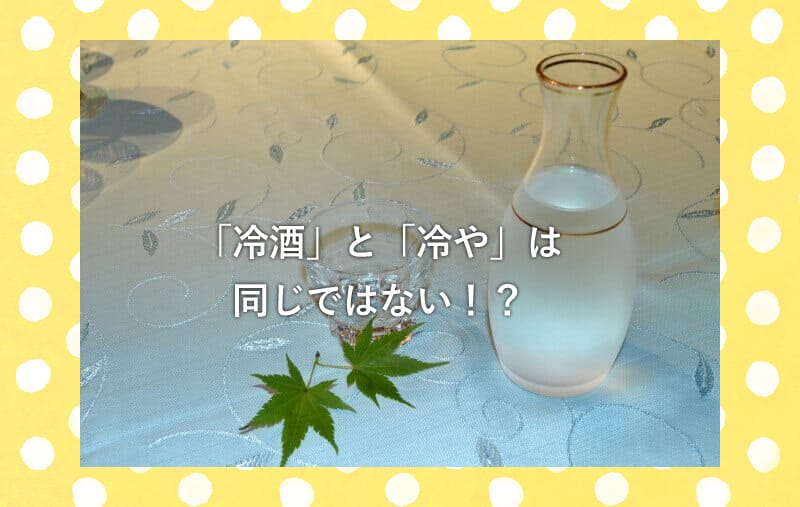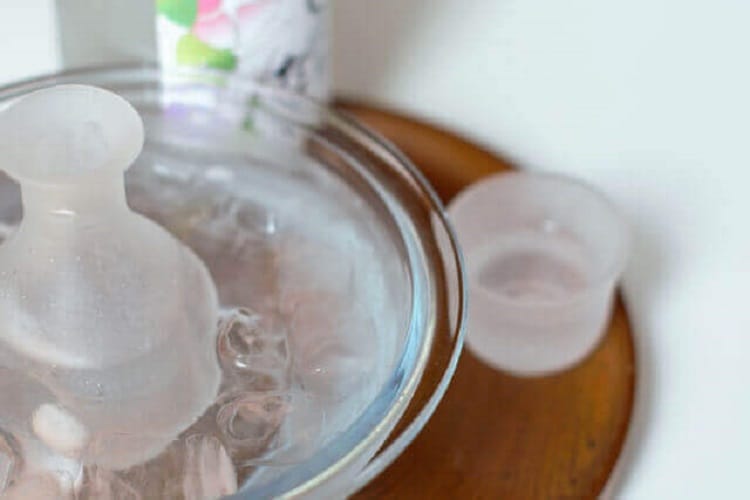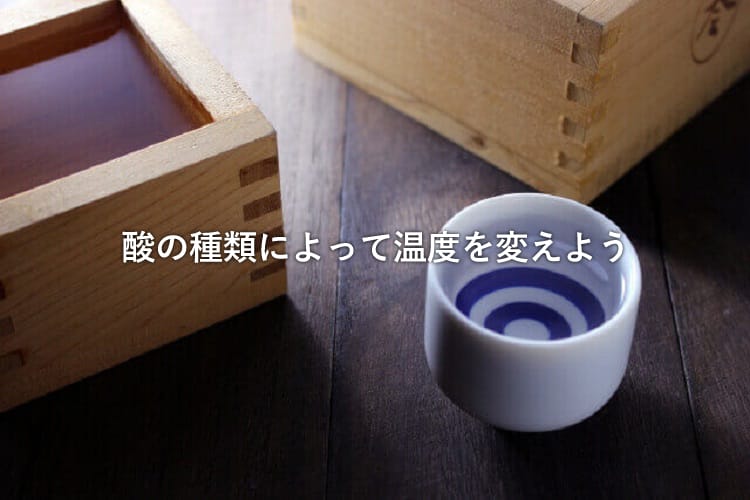
“Cold sake” and “cold” are not the same! ?

The unique personality that only Japanese sake and Japanese sake have,What you can enjoy in any temperature range.
Even if it is the same liquor, in the cold state, the fragrance is closed, or the acid is thorny and hard to drink, but if you warm it a little, the fragrant aroma will blossom, the acid will be mellow, the taste will be I'm often surprised at how much it increases and shows a completely different look.
The temperature range of such sake is roughly divided"Cold sake" "Cold" "Salmon"It is classified into three. You can see that “mochi” is a hot drink.
However, there may be many people who have a question mark in their heads saying, "Huh? Isn't that the same thing as" cold sake "?" I will explain the difference between “cold sake” and “cold” in order to solve such a moy.
Put simply,“Cold sake” is sake chilled in a refrigerator.. The temperature is about 5 ℃ ~ 15 ℃. And“Cold” means “normal temperature” sake.. The temperature is about 20 ℃.
In other words, "Cold sake" has a lower temperature than "Cold"It will be said.
So why are there misleading names such as “cold sake” and “cold”?
Actually,It is relatively recent that it is common to manage sake in the refrigerator and drink with `` cold sake ''It is. Until then, most of the sake was stored at room temperature, and when drinking, it was a style of drinking rice.
For this reason, alcohol at normal temperature was called “cold” in the sense of unwarmed liquor. The remnants of that era are still persistent.
However, the trouble is that there are differences in the perception of “cold sake” and “cold” depending on the bar. Even though I wanted to drink sake at room temperature, I ordered “please chill”, but the cold “cold sake” came out in the kinkin.
In order to prevent such a tragedy (?) In advance,It is recommended to clearly communicate the desired temperature whether it is normal or coldTo do.
What changes with temperature?

So, I will explain in detail what kind of sake changes with temperature.
·fragrance
Cooling will increase the freshness, but it will be a closed impression,The scent itself is hard to feel.
When warmed, the various elements spread and feel more understandable, but the refreshingness is lost.
・ Taste
When it cools, it feels volumeWeakly
When warmed, a sense of volumeStrengthened and mellowComes out.
·sweet taste
When you cool, you will feel refreshed and light,The sweetness itself is hard to feel.
When warmed,Feels firm and strongIt looks like Sometimes I get a bad impression.
·acidity
Cooling increases sharpness,Refreshing and refreshingIt will be.
When warmed, the softness increases and it feels mellow,The refreshing feeling is spoiled.
·taste
When it cools, it becomes light,The umami itself is hard to feel.
When warmed, the original taste of rice is brought out,Plump is strengthened. Sometimes it feels strange.
・ Bitter taste
When it cools, an exhilarating sharpness comes out and it becomes a tight impression,Feel hardIt looks like
When warmed, it becomes soft and mellow,Blurry without tighteningWill feel like.
·alcohol
When cooled, it becomes less volatile,Tight impressionIt will be.
When heated, it becomes more volatile,Feel stronglyIt looks like Beyond 50 ℃, you may feel a tingling irritation on your tongue.
Change the temperature depending on the type of acid

Let ’s talk about acid here, as it relates to temperature.
Organic acids in sake areIt is roughly divided into 2 types of “warm acid” (onshi-san) and “cold acid” (reishi-san).. In the process of brewing, it is derived from rice, rice bran and yeast.
First one"Warm umami acid" is an organic acid that tastes better when heated..Lactic acid, succinic acidThis is the case.
In the cold state, lactic acid is strongly stimulated by acid and feels thorny. As the temperature rises, the sweetness feels more, so it balances with the acid and plays an exquisite harmony.
The representative sake that contains a lot of lactic acid is made from ginger and mountain ruins.The potential is maximized by warmingLet's keep on the point.
Succinic acid is an umami ingredient that tastes like shellfish juiceis. The taste is mixed with sourness, bitterness, and sourness, and it gives sake a rich and rich taste. The acidity is soft and gentle.
Aside from that,Succinic acid also has the effect of eliminating the smell of fish and meatSo sake is often used in cooking.
And the second“Chilled acid” is an organic acid that, on the contrary to “warm acid,” enhances the taste by cooling.Say.Malic acid and citric acidThis is the case.
As the name suggests, malic acid is an acid that is abundant in fruits such as bananas and grapes. It is called like this because it was found in an apple. On the other hand, citric acid is abundant in citrus fruits such as lemon and orange.
In both cases, when warmed, the acidity becomes dull.You can enjoy a refreshing and sharp acidity by coolingIt has the feature of.
Japanese sake, which is rich in malic acid and citric acid, is a summer-limited liquor that has been named Daiginjo Sake and “summer sake” that is often seen in recent years. Because it has a refreshing taste, it cools down the hot summer comfortably.
The style of sake that changes with temperature

Sake that has a very wide temperature range.In fact, because of the abundance of temperature zones, names are given according to each temperature zone..
For the fineness to enjoy a slight change of about 5 ℃ unit,Deep love for sakeI can feel.
Please remember these names and taste characteristics that are full of Japanese delicacy and taste, and show them to your liquor friends. In particular, foreigners are often surprised and impressed.
・ 5 ℃ = "Snow cold" (Yukibie)
This snow cold is the state of chillingis. Ideal for enjoying a refreshing and dry taste. It is the perfect temperature for the first cup you want to go to, sparkling sake and activity.
However,The aroma is hard to stand and the taste is also tight because it closesYou may. Also, since the temperature is low, sweetness and umami taste are weak.
・ 10 ℃ = "Hana cold" (Hanabie)
Hana cold is a word that means that when the cherry blossoms are warm and the cherry blossoms bloom, the cold returnsis. It's also used in haiku seasons. In the world of sake,Chill 10 ℃Eur-lex.europa.eu eur-lex.europa.eu
The standard for cooling the flower is when it is just removed from the refrigerator after being cooled in the refrigerator for several hours.is. As soon as you touch the bottle, you feel cold.
The aroma is small and discreet,The taste comes together and the impression is meticulousIt becomes. This is the recommended temperature when you want to have a dry taste or drink with a sharp and sharp taste.
・ 15 ℃ = "Cool" (Suzubi)
The guideline for coolness is when you take it out of the refrigerator for a while.. Just as water droplets begin to appear in the bottle, it feels cool when you hold it in your hand.
Ginjo sake and Daiginjo sakeThis temperature is suitable for fruity types of liquor with a gorgeous fragrance.Sweet and gorgeous fragrance rises moderately and gives comfort..
Also, a mellow with a fresh feelingFresh sakeBut this temperature is perfect. You can enjoy a fresh scent and a sharp taste.
As an aside, when measuring the degree of sake, measure the specific gravity by floating a special buoyant scale (with lead grains in the bottom of the glass tube) on 15 ℃ sake. It has become.
・ 20 ℃ = 「Room temperature (cool)」
The temperature at which a slight cold is transmitted slowly when holding a bottleis. The room temperature between the soil in an old Japanese houseAbout 20 ℃It was.
In terms of your tongue, think of it as “not cold but not warm”. The characteristic of this temperature is that the hidden fragrance opens and the taste becomes softer at colder temperatures.
As I wrote earlier, “cold” means room temperature.Let's be careful that temperature is different from "cold sake" chilled in refrigerator.
By the way, this is the best temperature for making sake. If it is too cold, the scent will be difficult to stand. In fact, at the sake tasting party for professionals, all sake is served at room temperature.
・ 30 ℃ = "Hyuga Hinata" (Hinatakan)
Hinata to warm to a temperature of about 30 ℃, which is lower than the human body temperatureIs called. It's a nice naming with an image of a shiny fold.
If it is at this temperature, it will not feel hot or cold even if it is in your mouth. By using Hinata-anSake with a smoother and easier-to-drink liquor than normal temperatureIt changes to.
At this temperature, the odor of alcohol is not so high, so it is a recommended temperature for those who say “Sake is not good at that unique smell”.
・ 35 ℃ = 「Human Skin」
35 ℃ close to human body temperature is called human skin fold. It is a naming that makes you feel a little bit of colour.
If you take a bite, the warmth will spread gently in your mouth.You can enjoy the sweet and delicious flavor of rice and rice cakes..
In fact, I sometimes wrinkle with my skin. When you think “the liquor is a little too cold” or “the acid doesn't feel a little bit harsh”, hold the vessel with the alcohol in your hands for a while. Since neither gas nor electricity is used, it can be said to be a very eco-friendly way of warming (laughs).
It is said that the temperature at which humans feel the sweetest is about 37 ° C, which is slightly higher than body temperature.
・ 40 ℃ = 「Nuru 燗」
When you get a bottle of sake, you can feel a little warmth..Aroma increases, umami increases, and swellsIt will be.
This is the temperature at which liquor suitable for porridge is often the most potential.
・ 45 ℃ = 「上 燗」
The guideline for the upper pot is that it feels warm when you have a virtue, and the steam comes out when you pour it..
The scent is tightened, and the flavor is swelledCan enjoy. Many pure rice sakes shine most at this temperature.
・ 50 ℃ = 「Hot soup」
The temperature at which you can see steam from the bottle and feel hot when you hold it in your handHowever, it is a guideline for hot tub.The taste changes to a sharp and crisp, and the aroma is sharp..
In the past, rice cakes were usually drunk at the temperature around here.Most of the brewed sake and regular sake are the most delicious with hot potatoes..
By the way, there are many people who think that “hot sake = warm liquor”. “Hot” is a word that means warming sake, so “hot rice” means hot = high temperature.
・ 55 ℃ or above = “Jumping Spear”
At the end, the name that is hot is “flying rice cake”. Because the temperature has risen above 55 ° C, it is pretty hot to have a bottle of sake.
The scent becomes very strong, and I feel the irritation coming to my nose. In addition, the taste is extremely dry.Like and dislike, it can be said that it is the temperature to choose a drinker.
Anti-drinkers often drank consciousness about strong alcohol odors because they drank at this temperature at the beginning.
The flying kite isTemperature suitable for pure rice sake, brewed sake, and regular sakeis. Also,Aged liquorRecommended temperature. The unique aging incense is moderately relaxed and the ease of drinking is greatly improved.
